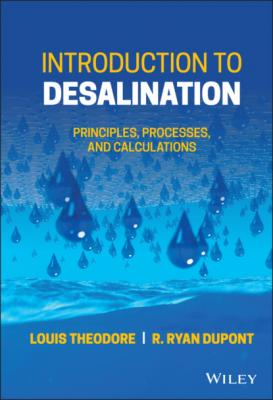Introduction to Desalination. Louis Theodore
Чтение книги онлайн.
Читать онлайн книгу Introduction to Desalination - Louis Theodore страница 16
 style="font-size:15px;"> 10 Lufkin, B. (2017). Future – Why ‘hydro-politics’ will shape the 21st century. BBC Future Now. http://www.bbc.com/future/story/20170615-why-hydro-politics-will-shape-the-21st-century (accessed July 9, 2021).
style="font-size:15px;"> 10 Lufkin, B. (2017). Future – Why ‘hydro-politics’ will shape the 21st century. BBC Future Now. http://www.bbc.com/future/story/20170615-why-hydro-politics-will-shape-the-21st-century (accessed July 9, 2021).11 McCrary, K. (2018). The politics of water development: A source of conflict? International association for political science students. http://www.iapss.org/wp/2018/02/28/the-politics-of-water-development-a-source-of-conflict (accessed July 9, 2021).
12 Mekonnen, M.M. and Hoekstra, A.Y. (2011). National Water Footprint Accounts: The Green, Blue and Grey Water Footprint of Production and Consumption. Volume 1: Main Report. Value of Water Research Report Series No. 50. Delft, The Netherlands: UNESCO-IHE Institute for Water Education. https://waterfootprint.org/media/downloads/Report50-NationalWaterFootprints-Vol1.pdf.
13 Mullen, K. (2021). Information on Earth’s Water. Westerville, OH: National Ground Water Association. https://www.ngwa.org/what-is-groundwater/About-groundwater/information-on-earths-water (accessed July 8, 2021).
14 Osborn, L. (2019). Number of reservoirs in the world. Current results. Weather and Science Facts. https://www.currentresults.com/Environment-Facts/number-reservoirs-in-world.php (accessed July 8, 2021).
15 Rekacewicz, P. (2006). Freshwater Resources: Volume by Continent. Arendal, Norway: GRID-Arendal. http://www.grida.no/resources/5608.
16 Stockholm International Water Institute (2005). Making Water a Part of Economic Development. The Economic Benefits of Improved Water Management and Services. Stockholm, Sweden: SIWI and the World Health Organization. https://www.siwi.org/wp-content/uploads/2015/09/waterandmacroecon.pdf.
17 Theodore, L. (2014). Chemical Engineering: The Essential Reference. New York, NY: McGraw-Hill.
18 Theodore, L., Dupont, R.R., and Ganesan, K. (2017). Unit Operations in Environmental Engineering. Salem, MA: Schrivener-Wiley.
19 Theodore, L. and Ricci, F. (2010). Mass Transfer Operations for the Practicing Engineer. Hoboken, NJ: John Wiley & Sons.
20 University of North Carolina Environmental Finance Center (2017). An Overview of Clean Water Access Challenges in the United States. Chapel Hill, NC: University of North Carolina at Chapel Hill Environmental Finance Center. https://efc.sog.unc.edu/wp-content/uploads/sites/1172/2021/07/An-Overview-of-Clean-Water-Access-Challenges-in-the-United-States.Final_.pdf.
21 US Water Alliance (2017). An Equitable Water Future. A National Briefing Paper. Washington, D.C.: US Water Alliance. http://uswateralliance.org/sites/uswateralliance.org/files/publications/uswa_waterequity_FINAL.pdf.
22 Water.org (2019). Brazil’s Water and Sanitation Crisis. Kansas City MO: Water.org. https://water.org/our-impact/brazil.
23 World Health Organization (2017). Progress on Drinking Water, Sanitation and Hygiene 2017. Update and SDG Baselines. Geneva. Switzerland: World Health Organization (WHO) and the United Nations Children’s Fund (UNICEF). https://apps.who.int/iris/bitstream/handle/10665/258617/9789241512893-eng.pdf;jsessionid=BFB5D93E1AC22CFE3A7EAB3C0F603BF9?sequence=1.
2 Technical Glossary
2.1 Introduction
This chapter provides definitions for many, but not all, of the terms that the reader will encounter in this book. It should be noted that some of the definitions specifically refer to the United States and that a good number of definitions pertain to wastewater and wastewater-related terms. It should also be noted that many of the terms have come to mean different things to different people, and this will become evident as one delves deeper into the applicable literature. Finally, the bulk of the material in this chapter was drawn from the earlier work of Theodore et al. (1997).
2.2 Glossary
Absolute humidity – The amount of water vapor present in a unit mass of air, which is usually expressed as kilograms of water vapor per kilogram of dry air or pounds of water vapor per pound of dry air.
Absolute pressure – The actual pressure exerted on a surface that is measured relative to zero pressure; it equals the gauge pressure plus the atmospheric pressure.
Absolute pressure gauge – A device that measures the pressure exerted by a fluid relative to a perfect vacuum.
Absolute scale – A temperature scale that is based on absolute zero and that uses units of measurement equivalent to Centigrade degrees on the Kelvin scale or to Fahrenheit degrees on the Rankine scale.
Absolute temperature – The temperature expressed in degrees Kelvin (K) or degrees Rankine (°R).
Absolute temperature scale – A scale (e.g. Kelvin, Rankine) in which temperatures are measured relative to absolute zero.
Absolute vacuum – A void that is completely empty of matter.
Absolute zero temperature – The temperature of zero degrees on either the Kelvin or Rankine scale at which molecular motion is thought to cease.
Absorbate – A substance that is taken up and retained by an absorbent.
Absorbent – Any substance that takes in or absorbs other substances.
Absorber – A device in which a gas is absorbed by contact with a liquid.
Absorption – The process in which one material (the absorbent) takes up and retains another (the absorbate) to form a homogenous solution; it often involves the use of a liquid to remove certain gas components from a gaseous mixture.
Absorption tower – A vertical tube or pipe in which a rising gas is partially absorbed by a liquid, usually in the form of falling droplets.
Acid – A material containing hydrogen that produces at least one hydrogen ion when dissolved in a water solution; it can react with and neutralize a base to form a salt.
Acre-foot – A measure of volume; 43,560 cubic feet, 325,900 gallons, or the volume of water covering 1 acre, 1 foot deep.
Action